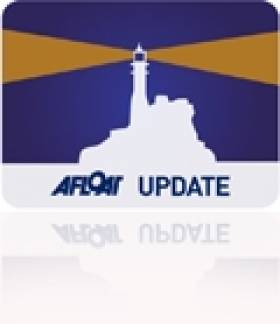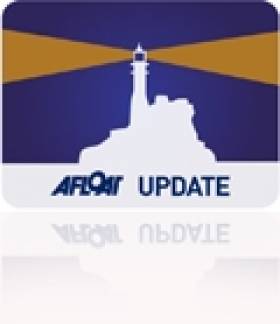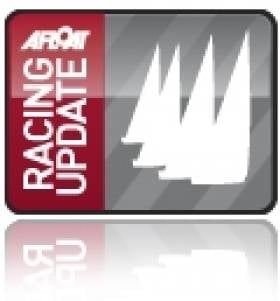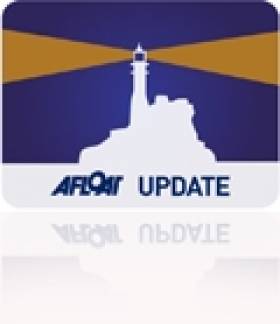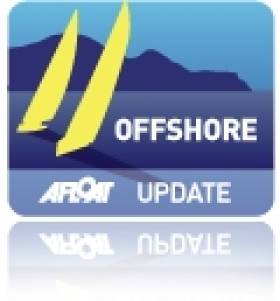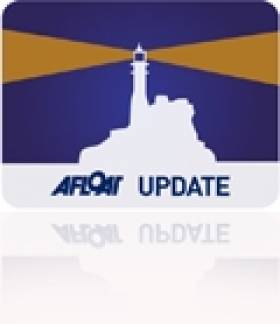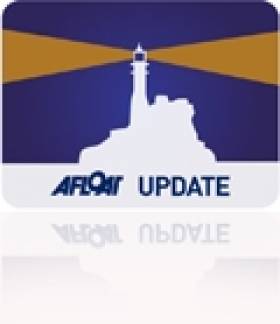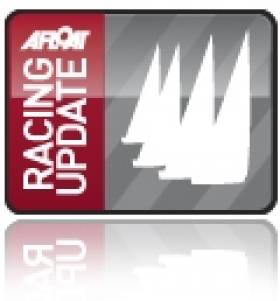Displaying items by tag: Fastnet
Fastnet Calling for a Dozen Boats of Irish Interest
Irish interest boats range from a round the world VOR 70 bearing Irish colours to a Cork based First 36.7.
Team Sanya will be racing in a refurbished version of the Telefónica Blue boat that finished on the podium in the last race and the new livery shown off after some furious work in Hamble, England displays a multicoloured design representing the phoenix, the mythical bird that has good-luck status in China.
Skipper Mike Sanderson left two spots open in the crew list he named on Saturday, with at least one of those places to go to a Chinese sailor.
Irishman Frankie Leonard had already been announced as Media Crew member. See here for his first blog.
Navigator Aksel Magdahl was among the stand-out names on a sailing team list with a distinct New Zealand flavour.
Joining Sanderson, himself a Kiwi, are fellow New Zealanders Richard Mason, Chris Main, Andy Meikeljohn, Ryan Houston, and Cameron Dunn.
Sanderson will use the Rolex Fastnet Race, which starts on August 14, to give a trial to China's Teng Jiang He, nicknamed Tiger.
"Despite starting this campaign late in the day, I am really excited about the team we have gathered together and that applies to both the sailing and shore team," said Sanderson.
"Without realising it, we have a really young and ambitious sailing team – the average age is 33 and I am the oldest at 40.
"We have managed to bring together a combination of experience in all of the right areas as well a fresh and innovative approach and that feels really right for this team.
"We still have two sailing team members to announce and we have our first Chinese sailing team member, Tiger, on a trial with us now and he will compete in the Fastnet race with us so all is progressing really well."
Sanya will be up against Volvo Ocean Race rivals Abu Dhabi Ocean Racing (with Wexford's Justin Slattery) and Groupama (Kerry's Damian Foxall) in the Fastnet.
One of Dun Laoghaire's leading offshore campaigners Legally Brunette (Cathal Drohan and Paul Egan) is poised to start the Fastnet for the second time. The boat is doing the race with regular crew, save that Frank Allen, one of our regulars, is substituting for Cathal Drohan as skipper, as Cathal has personal commitments that prevent him racing.
Legally Brunette has had a reasonable run of success since getting the boat in 2007. They came second in the 2007 Dun Laoghaire Dingle with regular crew, losing out to Aquelina on adjusted time of roughly 30 minutes in a slow race. Two years later Prof O'Connell was able to improve on this in 2009 by coming first using some of our regulars as well as some of his own favourite crew.
In the 2009 Fastnet Legally Brunette was 106th out of 266 on the first attempt. The ambition, says Egan is to try to improve on that and 'enjoy our sailing while we're at it'.
In the 2009 Fastnet Race Legally Brunette was snookered near the start by Portland Bill. There was a slow start and although the very big boats were able to make the tidal gate there, the smaller ones had no chance of so doing. They made a late decision to tack out and would probably have been better to do so earlier. The crew's recollection of the beat to the Fastnet is not a fond memory – it was wet, cold, misty and miserable – all we saw of the Fastnet rock were the breaking waves on the rocks there, as visibility was down to a few boat lengths. 'Part of our drive to do the race again is to exorcise that memory' says Egan.
Others ready for the start are Adrian Lee's Cookson 50 Lee Overlay and Dutch yacht and current Round Ireland race winner Piet Vroon's Tonnerre de Breskens.
Dun Laoghaire sailing school have entered their yacht Sailing West, Liam Coyne's First 36.7 Lulabelle is in and Barry Hurley's Transatlantic winner Dinah is also entered, as is Paddy Cronin's Psipina and David Gibbons Joker.
Irish Yachts Line Out for the Fastnet Race
ARABELLA, J111, Niall Dowling
Niall Dowling and Nick Smyth will be co-skippering the J111 'Arabella' under the burgee of the Royal Irish Yacht Club. 'Arabella', the first J111 in Europe, has had an extensive offshore campaign since winning the Hamble Spring Series in April. The Fastnet Race is the focus of their 2011 campaign.
Arabella currently lies 2nd out of over 300 boats in the RORC Overall Championship Series behind Piet Vroon's Kerr 46 Tonnerre de Breskens. Crew for the Rolex Fastnet will include Class 40 sailor, John Cunningham, GBR Olympic Finn coach Matt Howard and Volvo sailor Craig Bowie. Also on board is Dowling's long term friend, skipper and double handed campaigner Michael Boyd. Boyd is a veteran of many Fastnet campaigns, the first of which was on the Irish Admirals Cup team in 1983, will further bolster the offshore experience. The dynamic duo of Peter Knight and Aaron Cooper both amongst the elite graduates of the Solent Keelboat Academy will cover roles of bowman and navigator respectively.
When asked about the campaign Dowling commented: "This campaign is all about getting a group of friends that used to sail a lot together, back out there. Nick and I used to race dinghies, instructed sailing together in Dun Laoghaire and campaigned offshore. Nick has been doing lot of competitive team racing but until this campaign, the last offshore race we did together with Michael was the Round Ireland Race in 2006."
"The RORC Eddystone Race in May definitely showed there were no cobwebs as Nick drove most of the way back from the lighthouse topping out at 22.6 knots and averaging mid teens! John, although normally based in the US, has been doing a fellowship at Cambridge University and has been on board since the boat arrived".
Irish Olympic Finn sailor Tim Goodbody and the National Yacht Club's now Brighton based boat designer Jonny Coate are also regulars on board. For the Rolex Fastnet there will be a competitive fleet of 77 boats in IRC2 where Arabella currently lies 2nd in the series behind RORC commodore Andrew Mc Irvine's First 40 La Reponse.
DINAH, JOD35, Barry Hurley
Owner and skipper Barry Hurley will also be flying the flag for the Royal Irish Yacht Club onboard Dinah, a JOD35.
Barry will be sailing with Andy Boyle and between them they have clocked up an impressive amount of racing, including three transatlantic, three Round Ireland Races, two full RORC series campaigns and many more fully crewed regattas,including Cork Week, Sovereigns Cup, etc.
Barry won his class and was fourth overall on Dinah in the 2009 OSTAR (solo transatlantic). The Fastnet Race is one of the few major middle distance
offshore races in the world that neither Barry nor Andy have completed and 2011 is the year to tick that box.
SPIRIT OF JACANA, J133, Bruce, James and Alan Douglas, Carrickfergus, Co. Antrim
This boat is owned by the three Douglas brothers. The brothers and most of the crew are ex Scorpion dinghy sailors from Northern Ireland. The brothers previously owned a J35 Jacana and in this were class winners at Cork Week and at the Scottish series.
This really is a family affair as two of the brothers sons are also competing, Keith and Cameron Douglas. Cameron has a busy summer as he is representing RYA Team GBR at the ISAF Youth Worlds in the Laser Radial class in July and also at the Team Race Worlds in Ireland in September.
This is the first Fastnet Race for the crew who have sailed in a number of offshore races in Ireland and Scotland. "Having competed at various racing events such as Cork Week and Scottish Series, we wanted to take on other challenges. [Our goal for the Fastnet will be] to finish the race and enjoy the experience!"
Racing Round up: Dragons, British IRCs, Flying Fifteens, WIORA, ISA Youths, Fastnet and Bay racers
'Arabella' currently lies 2nd out of over 300 boats in the RORC Overall Series behind Piet Vroon"s Kerr 46 Tonnerre de Breskens. Crew for the Fastnet will include Class 40 sailor John Cunningham, GBR Olympic Finn coach Matt Howard, Volvo sailor Craig Bowie. Also on board Dowling's long term friend, skipper and double handed campaigner Michael Boyd a veteran of many Fastnet campaigns the first of which was on the Irish Admirals Cup team in 1983 will further bolster the offshore experience. The dynamic duo of Peter Knight and Aaron Cooper both amongst the elite graduates of the Solent Keelboat Academy will cover roles of bowman and navigator respectively.
When asked about the campaign Dowling said "this campaign is all about getting a group of friends that used to sail a lot together back out there. Nick and I used to race dinghies, instructed sailing together in Dun Laoghaire and campaigned offshore. Nick has been doing lot of competitive team racing but until this campaign the last offshore race we did together with Michael was the Round Ireland race in 2006 ... . The RORC Eddystone Race in May definitely showed there were no cobwebs as Nick drove most of the way back from the lighthouse topping out at 22.6 knots and averaging mid teens! John although normally based in the US has been doing a fellowship at Cambridge University and has been on board since the boat arrived". Irish Olympic Finn sailor Tim Goodbody and the National Yacht Club's now Brighton based boat designer Jonny Coate are also regulars on board. For the Fastnet there will be a competitive fleet of 77 boats in IRC2 where 'Arabella' currently lies 2nd in the series behind RORC commodore Andrew Mc Irvine's First 40 'La Reponse'.
Kinsale Heads for 100-mile Fastnet Race
Kinsale Yacht Club's SCORA League Fastnet Race sponsored by CH Marine takes place this Friday at 8pm.
This 100–mile round trip to one of the most iconic ocean racing turning points presents all the challenges to competitors associated with classic offshore/coastal racing.
The many headlands along the track present major tactical decision points for skippers and navigators in their race to make the many tidal gates along the route. This coupled to the often fickle winds make the creation of a race winning strategy extremely difficult.
This now classic race on the South Coast typically attracts competitors from the host Club Kinsale Yacht Club along with competitors from the Royal Cork and Cobh Sailing Club.
The inclusion of the Kinsale Fastnet in SCORA Jim Donegan Memorial Series enhances the standing of this race along the South coast and the very generous sponsorship of this race by CH Marine makes the race highly attractive for South coast sailors.
Intending competitors are reminded that this is a ISAF OSR Cat 3 race with life rafts. Safety checks may be conducted prior to the start.
Preparing for the Challenge of La Solitaire du Figaro
Dubliner Paul O'Riain's comprehensive article on his Figaro debut experience in 2007 has moved, Click this link for it and the latest La Solitaire du Figaro news.
Fastnet Race Limit Increased
The Rolex Fastnet Race reached its entry limit 10 days after opening and over 130 boats are on the waiting list. "We were staggered at the speed with which people signed up," said RORC Commodore Andrew McIrvine. "We had to do something to satisfy the huge interest, and taking the non IRC yachts out of the total is a fair solution allowing more loyal RORC racers to get their boats into the race."
Removing the non-IRC classes will add about 50 more places to the total. "We are delighted that the Volvo's and IMOCA's want to compete in the race and that the Class 40's are coming en-masse," said RORC Chief Executive, Eddie Warden Owen. "It shows the popularity of the Rolex Fastnet that these professionally sailed boats want to join the race. However without this initiative, they would be taking valuable places away from less experienced offshore racers who view this race as a great personal challenge - their 'Everest' of sailing."
Sutton Harbour increase berthing capacity
To cater for the number of boats arriving in Plymouth, Sutton Harbour Marina has increased the amount of space by making the whole of the berthing area adjacent to West Pier and the Barbican available to the Rolex Fastnet fleet. Sutton Harbour has also become the official berth provider for the race and Chief Executive Nigel Godfroy is pleased to be associated with the race. "Sutton Harbour Marina welcomes the return of this world famous race," said Nigel. "We are very proud of the quality of facilities we have here in Sutton Harbour and being selected as the official berthing provider for the Rolex Fastnet Race. We look forward to welcoming the extra large fleet in August this year."
To accommodate the increased number of entries, space has been booked in Queen Anne's Battery, adjacent to Sutton Harbour and in Plymouth Yacht Haven in the Cattewater, where a water taxi service will be set up to connect competitors with the race office based at Sutton Harbour.
The 2011 Rolex Fastnet Race starts in Cowes, Isle of Wight on Sunday 14 August.
250 entries within a week brings Fastnet Race Close to Limit
"We expected an initial rush of interest because people were registering the details about their boat on our REMUS on-line entry system over Christmas," commented the RORC Racing Manager Ian Loffhagen. "However nothing had prepared us for this unprecedented amount of interest in the race. We are obviously delighted at how popular the race has become with entries from all over the world."
Officially the first boat to enter was Fred Mundle's X332 Mardy Gras, only 50 seconds after entry opened. Another notable early entry is Ondeck's Farr 65 which will be chartered by the British Limbless Ex Service Men's Association (BLESMA).
Of the high profile race boats entered, the two canting keel 100 footers, ICAP Leopard and Rambler 100 will be the ones battling to take line honours in the Race. Mike Slade's ICAP Leopard and George David's previous Rambler had a huge fight in the 2007 Rolex Fastnet Race, with Leopard taking the silverware. However, this year, George David has chartered the Juan K designed Speedboat, re-named Rambler 100, which will put Mike Slade under a lot of pressure.
"The Rolex Fastnet is an iconic race," said Slade. "We would not miss it for the world and we are pleased to see our American friend George David coming back with a new boat. It will make for a terribly exciting race."
Also entered is the 2009 Rolex Fastnet Race winner, Niklas Zennström's J.V. 72, Rán, hoping to make it two in a row, but he will have strong competition from RORC Caribbean 600 Race winner, Hong Kong's Karl Kwok in his Farr 80, Beau Geste; 2009 Rolex Middle Sea Race winner, Andre Soriano in his Mills 68 Alegre, as well as a group of very competitive 52' grand prix racers.
Leading this 50 footer pack is the 2010 Rolex Middle Sea Race winner, the TP52 Lucky, owned by Breyon Ehrhart from the USA and four boats from Germany who are making a serious attempt to win the race this year: Uwe Leben's RP57, Scho-Ka-Kola; the SKWB's J.V.53 Bank von Bremen and Haspa Hamburg and Norddeutsche Vermögen, both from Hamburgischer Verein Seefahrt.
There are 15 Class 40's entered so far and the next biggest classes are the Sigma 38 and First 40.7s, with 14 boats each and so far, 14 different countries will be represented in the 2011 Rolex Fastnet Race which starts in Cowes, Isle of Wight on Sunday 14 August.
Race website: HERE
Spinnaker on Top in Team Racing National Championships
Last weekend's The Irish Team Racing Association National Team Racing Championships attracted it's largest entry for many years, with 21 teams registered.
The event was hosted by the Fastnet Marine and Outdoor Education Centre in Schull, West Cork.
Four teams travelled over from the UK, and 6 under 19 teams, all from County Cork, competed. They joined the keenest of the post-college teams and the leading university teams to constitute the largest Championships that Ireland has seen for many years. Schull, the venue for next year's World Championship, was a major attraction, but the change of date, from March to November, has made it easier for college students and school pupils to attend.

Weekend Team Racing action from Schull. More photos HERE. Photos: Brian Carlin
The weather forecasts had been predicting storms, floods and general mayhem for days if not weeks beforehand. But Saturday dawned to reveal Schull Harbour in an unusual state – the wind had disappeared! Racing started 3 hours later than planned. However, by the end of the day the first round had been completed. This was a seeded round robin, with each of the four League made up of a UK team, a leading Irish team, a leading college team and two others, including the youth teams.
The results of the first round determined entry into the second round – all the UK teams won all four leagues, with the George Knights, the George Gladiators, Supertroopers and UCD finishing second. These teams were joined in the Gold Leagues of the second round by the winners of play-offs between third place teams. The Bumsby Babes, a youth team from Royal Cork YC, had done well to win 2 races to qualify for a play-off against University of Limerick and they were in a strong position when equipment failure meant that one of their boats retired . In the subsequent re-sail UL managed to win the race and qualify.
On Sunday morning Schull was looking it's best in bright but cold sunshine. Unfortunately, the beauties of the West Cork landscape were exactly mirrored in the unruffled water of the harbour! Competitors, who had made a remarkable effort to arrive on time for an 0900 start, barely recovered from the reception organised the previous evening by the World Championship Committee, waited. When racing eventually got underway, in a fitful breeze, it quickly became obvious that there was no possibility of finishing the second round. Plan B was implemented, a knockout round between the four winners of Round One to determine the outright winner, another between the 4 Irish team placed second in the Round One Leagues to determine the ISA medal places and a Youth round.
GP14 World Champion Ian Dobson in Schull
Spinnaker came through the semis and final to win overall first place. The two Royal St George teams qualified for the final. Last year's winners, the Gladiators won the first race only after finishing places were confirmed by a redress hearing. However, the more experienced Knights went on to win the next to races to reclaim the trophy they had "lent" to the Gladiators last year. The third place play-off, which saw some of the noisiest races of the weekend, resulted in a win by Supertroopers over UCD.
In the Youth event Schull A beat Schull B to win the opportunity to take on, and eventually defeat the Bumsby Babes.
Next year's Championship will be sailed out of the Royal St. George on 12-13 November. However the next challenge for Irish team racers will be qualification for the World Championship, with selection trials planned for both the Youth and Open categories early in 2011.
The event was also the first opportunity to try the new TR3.6 which will be used for the Team Racing Worlds. Video below of the new TR3.6 and voice over from Team Racing World organiser David Harte in Schull. Stills by Brian Carlin HERE.
Team Racers Head for Schull
This season's Irish Team Racing Association's (ITRA) National Team Racing Championships will be sailed in Schull on 13th - 14th November. As excitement mounts for next year's ISAF Team Racing Worlds, entries for this year's event have hit a record 21. With 4 teams travelling from the UK, 6 Youth teams, all from Munster, the two Royal St George teams, quarter finalists in this years UK Open (better known as the Wilson Trophy), plus the top college teams the competition should be intense.
To ensure that the competition is fair and sailed to the rules the umpire team includes 4 International Umpires, and includes umpires from the USA, the UK and even Dublin. Race organisation by the Fastnet Marine and Outdoor Education Centre will provide a full dress rehearsal for next year's event. A presentation of plans for the Worlds will be held on Saturday evening, but for competitors the major attraction will be the opportunity to sail the prototype of the specially designed boat that will be used next year.
Following this event the top Irish team racers will be invited to put themselves forward for selection for the teams to represent Ireland in both the Open and under 19 categories at the Worlds. ITRA will invite selected teams to a trial event to be held early in 2011.
For further information please contact: Gordon DAVIES, Secretary, Irish Team Racing Association. Ph; 086 150 1220


























